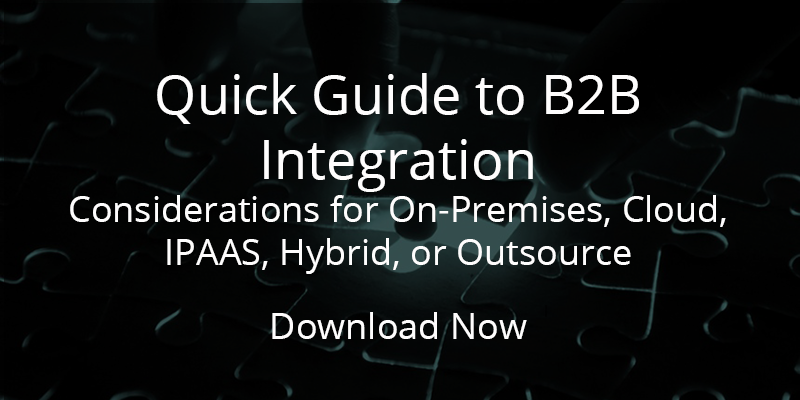
When it comes to choosing a B2B integration approach, you have four primary options: on-premises (integration software installed on a server at an organization’s site), hosted (integration software installed on a server off-site), cloud (integration software delivered over the internet), and hybrid (integration functionality utilizing two or more of the above). How do you know which of them is right for you?
To answer that question, there are many factors to consider as you select a B2B integration approach. You want to make sure you choose the right method for your company because to change course is expensive and time-consuming. In this video, Brad outlines the four basic categories of items to consider:
- What kind of competitive edge the B2B integration approach will give you
- The cost of the approach
- What impact the approach will have on your staffing needs
- What kind of security the approach provides
A Note about the Terminology
There remains some confusion about on-premises, hosted, cloud, and software-as-a-service (SaaS) that needs to be cleared up before proceeding.
To be clear, on-premises, hosted, and cloud are deployment architectures. These terms define where your software will be deployed as well as the connectivity and access you will have to your B2B integration solution.
SaaS, on the other hand, is a licensing model that is often lumped in with cloud solutions. It can be compared to the perpetual licensing model, under which you pay upfront for your license. Think of SaaS as renting your software. SaaS has no bearing on where your software is deployed, but it’s often related to cloud solutions in everyday references.
It is also entirely possible that you could run an on-premise deployment in a private cloud, or that you could negotiate a SaaS payment model for your on-premise deployment.
Consider the following factors that will affect which B2B integration delivery mechanism might be right for your organization.
For What Kind of Competitive Edge Are You Looking?
Different B2B integration approaches offer differing competitive advantages. The type of competitive advantage you seek will dictate the B2B integration approach you will take. The cloud has made headlines for the advantages it brings companies. “It’s cheaper!” headlines blare. “It’s faster!” However, the cloud might not be right for everyone.
Yes, the cloud does offer a faster implementation time than an on-premise B2B integration software deployment. There is a single instance of software, and it is a standard solution.
The standard solution part is where some companies run into problems. If you need substantial customizations, unique capabilities, integrations, or your technology solution is customer-facing, cloud B2B integration solutions may not be right for you. Customizations and integrations increase the cost of cloud solutions, if they are even possible, and add time to the deployment.
If it is a customer-facing solution, it will look very similar and have similar capabilities to other cloud solutions on the market. Your competitive advantage disappears because you look too much like your competitors, and your solution is unable to accommodate complex integration requirements.
On-premise solutions might have longer deployment periods, but there is a greater flexibility for customization and functional support for unique integrations. Customer-facing solutions will look original.
What Does the Approach Cost?
No matter how big your company is, the cost is a major factor when considering B2B integration solutions. Each approach has a different cost attached to it.
As an example, consider the cost of on-premises B2B integration solutions first. You generally pay for on-premises software upfront. On-premises software is more expensive than cloud B2B integration solutions. It generally also entails paying annual maintenance fees.
Cloud, on the other hand, has a lower upfront cost. It is considered a service, although you may pay maintenance fees. You are billed a set amount per month. On the other hand, if you keep your on-premises solution around for long enough, it might be cheaper than paying the cloud subscription fee in the long run.
The upfront costs and the maintenance costs are not the only things to consider. You also must look at what it will cost you to upgrade. Cloud B2B integration solution upgrades will be free or cheaper than on-premises upgrades.
Additionally, you should factor in the costs of IT support. Cloud B2B integration solutions will require lower levels of IT support because someone other than your staff is maintaining them. Conversely, on-premises B2B integration solutions require greater IT resources, which is costlier for a firm. You are running your own infrastructure in an on-premises B2B integration solution deployment, so you bear a greater responsibility for maintenance and daily operation.
Hosted solutions are like cloud B2B integration solutions in that you are not responsible for infrastructure or maintenance but do bear the cost of the software. You can apply much of the information on cloud costs to hosted B2B integration solutions when you are considering deployment options unless you elect to have your staff work in the hosted environment.
What Impact Will the B2B Integration Approach Have on Staff?
Staffing is always connected to the cost of a B2B integration solution. The reason it deserves its own section is that there are other, broader issues.
When you deploy an on-premises B2B integration solution, you need employees to support and maintain it. Those employees might be permanent, or they might be contractors or consultants from an integration managed services provider.
If you are hiring permanent or contract employees, you need to spend the time recruiting them, training them, managing them, and retaining them. Those tasks bear both a financial and administrative considerations.
Choosing a hosted or cloud deployment, on the other hand, places the staffing burden squarely on the service provider. That company must hire its own staff, train them, manage them, and retain them. You save money as well as hassle.
Yet, sometimes the burden of staffing is worth undertaking. When you employ staff or contractors, you have greater control over them. You cannot govern what goes on at your service provider’s facility; an employee there could commit a data breach or even do something unintentional that puts your firm at risk.
Considering that possibility, you must perform a measure of due diligence regarding risk assessment to get a true picture of how your chosen deployment approach will impact your organization from a human capital perspective.
What Is the Most Secure Deployment?
Answering the question about which is the most secure B2B integration deployment is not as straightforward as you would think.
The security of your on-premises B2B integration solution depends on how great your firm's security is. You control the security of an on-premises B2B integration solution because it is on your server. That can be a double-edged sword; if your security practices, in general, are weak, your B2B integration solution will be at risk. You are the one who must take care of backups, updates, and other routine maintenance measures that are typically undertaken to ensure the system is safe, as well as work in collaboration with your security personnel.
When you choose a hosted or cloud B2B integration solution, the burden of security shifts to the service provider. Again, there is not a clear-cut answer to whether this is the right approach for you. It will depend on how seriously your provider takes security. Today, many service providers boast the highest levels of security, so it becomes less of a concern.
However, your security concerns will also be strongly linked to how highly regulated your industry is as well as your customers’ preferences and regulatory burdens. The more regulated your industry (or that of your customers), the more sense an on-premise deployment will make. You control your data in an on-premise B2B integration solution deployment, not a third party. Your customers might also demand that only you have access to their information and that it is kept out of a third party’s hands (either because of data security fears or because of regulatory compliance).
Regardless of which deployment method you use, you cannot take security lightly. In today’s business world, data is currency, and it is constantly under threat from criminals.
Even accidentally releasing confidential data (such as that belonging to customers) has serious repercussions. Your reputation will suffer. Even if you are not in a particularly highly regulated industry, data security regulations have become more and more stringent.
Take the General Data Protection Regulation (GDPR), for example. It is an initiative of the EU and went into effect in May 2018. Even though the regulation is European in origin, it extends far beyond the EU’s borders and applies to companies that handle data of European citizens. The financial penalties are quite high, to say nothing of the damage your reputation will take if you violate GDPR.
As Promised, Your Quick Guide to Integration Choices!
Deciding on which B2B integration approach is right for your firm is not a one-size-fits-all process. That is why the Remedi team has created a handy comparison chart with information about how to make your choice easier. Here’s your link to Quick Guide to Integration Choices. Enjoy!
As you can see from our quick guide, your decision will be based on your unique situation, such as competitive differentiation, cost, staffing concerns, and security just to name a few. If you want to know more about which approach is right for you, contact us today to tap into the expertise of Remedi's integration experts!



